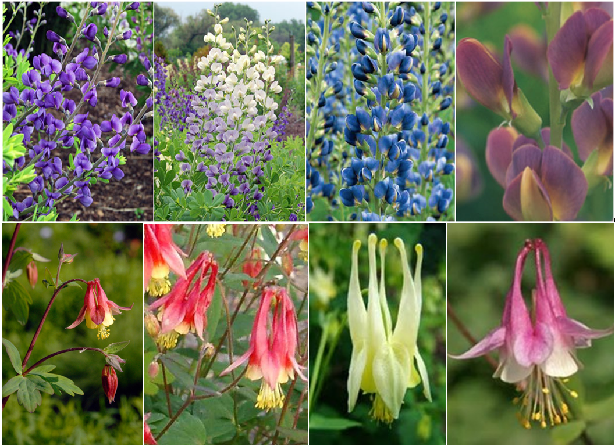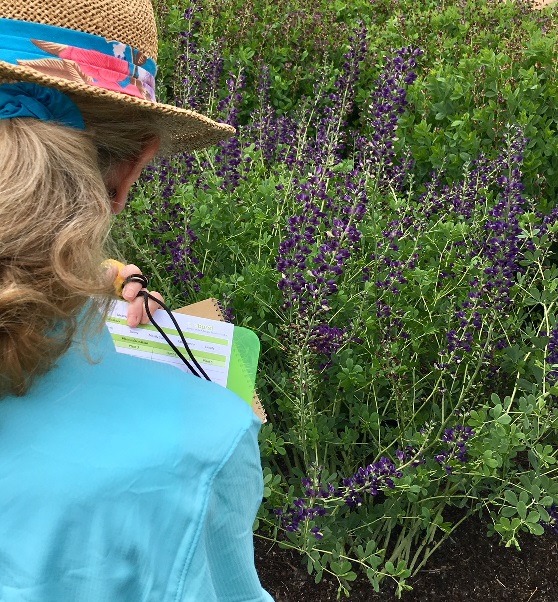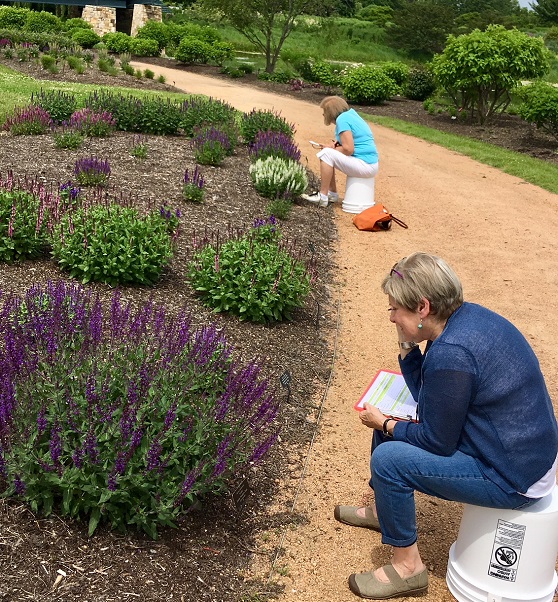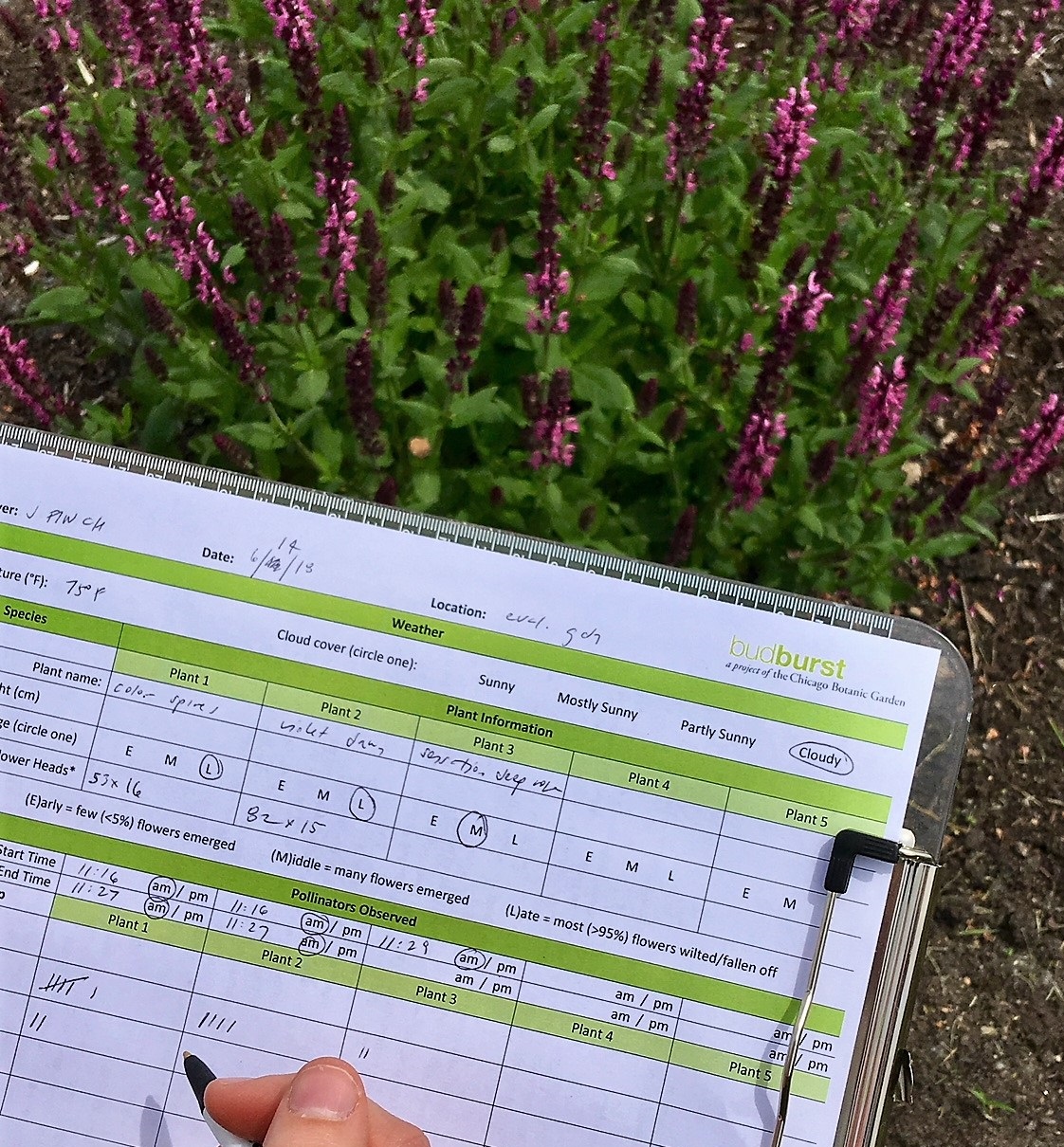Projects
We know that native bees, butterflies, and other pollinators have a preference for native wildflowers and trees.
One of the questions many gardeners have is about cultivated varieties of native plants, sometimes called “nativars.” Nativars can be different from their native parents in flower color and scent, the shape or number of flowers and petals, phenology, foliage color, and more. Since color, scent, timing, and size of flowers are very important to pollinators, it is easy to imagine that nativars might be more, or less, attractive to pollinators than the wild (native) species. They may even attract a different group of pollinators all together. Gardeners and scientists alike are wondering:
Scientists need your help to answer this important question.
All it takes is a few clicks. Start observing today. Join Budburst

Which one of us would win a bee popularity contest?
(Top) False indigo (Baptisia australis for those who love latin) is a native species with many popular cultivars, including Baptisia 'Lunar Eclipse,' Baptisia 'Midnight' and Baptisia 'Twilight.' As you can see, flower color varies dramatically. However, we do not know if this variation impacts pollinator use.
(Bottom) Cultivars of the native species red columbine (Aquilegia canadensis), include Aquilegia 'Little Lanterns', Aquilegia 'Pink Lanterns' and Aquilegia 'Songbird Goldfinch.' Flower size varies among them, as well as flower color.
Create your Budburst account or login to submit to the Nativars Project
Plant your garden
Hone your skills and stay informed about the project.
Submit your data!
.png)
Where?
Almost everywhere! Four botanic gardens—Chicago Botanic Garden, Denver Botanic Gardens, North Carolina Botanic Garden, and San Diego Botanic Garden—are joining forces with community scientists across the country to investigate whether nativars provide the same pollinator service as natives. Since in spring 2018, we’ve been planting popular native species alongside their nativars to compare pollinator use. The best part? You can participate from anywhere you are.
The project includes plants suitable for most US locations. Check the project species table to select plants appropriate for your growing zone.
It’s easy. Participants watch plants until they come into bloom, and then complete weekly 10 minute observations while flowers are blooming and record the number and type of pollinators that visit. Data will be uploaded via the Budburst data portal.
You can participate by:
Planting some or all of our target species in your own garden (or in a large container on a porch or patio) and becoming a pollinator observer.
If you're not a gardener, just visit any of our Nativar garden sites and collect and submit pollinator data from the plants there.
If you are planting these species to monitor in your own garden, be aware they need time to get established and may not all bloom the year you plant them. Don’t worry, they’ll bloom the next year and the project runs through fall 2022. You’ll have plenty of time to contribute pollinator data. In the meantime, if you are close to one of the partner sites, observe plants there to hone your skills and collect data.
Our scientists have identified 5 native species with four nativar cousins that grow well in each of three different climates. The species list below will help you decide which will grow best in your garden. You can choose all five native species with their nativars, or only one depending on the space you have available. Consider how they grow, how big they get, and what you personally find the most attractive.
Chicago Botanic Garden & North Carolina Botanical Garden | Denver Botanic Garden | San Diego Botanic Garden | |
Hardiness Zone | 4-8 Several have wider temperature tolerances. Plants are suited to most Midwestern and Eastern U.S. gardens. | 5-8 Most have wider temperature tolerances. Some Rudbeckia varieties may not survive extreme cold at higher elevations Plants are suited to most Great Plains and Rocky Mountain region gardens. | 7-9 All of these plants are suited for gardens in the southwestern U.S. and many will do well in mild climates further afield. |
Spring | Aquilegia canadensis Red columbine ‘Corbett’ ‘Little Lanterns’ ‘Pink Lanterns’ ‘Songbird Goldfinch’ Penstemon digitalis Foxglove beardtongue ‘Husker Red’ ‘Pocahontas' ‘Blackbeard’ | Achillea millefolium Common Yarrow ‘Pink Grapefruit’ ‘Desert Eve Deep Rose’ ‘Terracotta’ ‘Moonshine’ Aquilegia coerulea Colorado blue columbine ‘Colorado Violet & White’ (a.k.a. 'Remembrance’) ‘Songbird Dove’ ‘Songbird Cardinal’ ‘Songbird Nightingale’ | Ceanothus thyrsiflorus Blueblossom ‘Skylark’ ‘Snow Flurry’ ‘Frosty Blue’ Heuchera maxima Jill of the rocks ‘Old La Rochette’ ‘Wendy’ ‘Susana’ Rhamnus californica California buckthorn ‘Mound San Bruno’ ‘Eve Case’ ‘Little Sur’ Salvia clevelandii Fragrant sage ‘Aromas’ ‘Japatul’ ‘Arroyo Azul’ ‘Winifred Gilman’ |
Summer | Rudbeckia fulgida Black-eyed Susan ‘Viette's Little Suzy’ ‘Goldsturm’ ‘Little Goldstar’ ‘American Gold Rush’ | Rudbeckia hirta Orange coneflower ‘Cherry Brandy’ ‘Irish Eyes’ ‘Cherokee Sunset’ ‘Denver Daisy’ | Salvia clevelandii Fragrant sage ‘Aromas’ ‘Japatul’ ‘Arroyo Azul’ ‘Winifred Gilman’ |
Fall | Symphyotrichum novae-angliae New England aster ‘Purple Dome’ ‘Andenken an Alma Potschke’ ‘Harrington’s Pink’ ‘Vibrant Dome’ Symphyotrichum oblongifolium Aromatic aster ‘Dream of Beauty’ ‘October Skies’ ‘Raydon’s Favorite’ | Symphyotrichum novae-angliae New England aster ‘Purple Dome’ ‘Andenken an Alma Potschke’ ‘Septemberrubin’ ‘Mrs S T Wright’ Symphyotrichum oblongifolium Aromatic aster ‘Dream of Beauty’ ‘October Skies’ ‘Raydon’s Favorite’ ‘Raydon’s Birthday Pink’ | |
Winter | Ceanothus thyrsiflorus Blueblossom ‘Skylark’ ‘Snow Flurry’ ‘Frosty Blue’ |
The plants selected for the Nativars Project may be small when you bring them home, but they won’t stay that way! If you are only planning to leave these plants in your garden for the length of the project (through 2022), plant them two feet apart. If you’d like to leave them permanently in your garden, plant them at 3-4 feet apart. They’ll live many years (to decades in some cases).
These plants should do well in typical garden soil, not too wet or dry, and full sun. Some will tolerate light shade (particularly the columbine, Aquilegia, Geranium, and Geranium maculatum). Follow typical gardening practices, watering well when planted and regularly through the first growing season if the soil dries out. After they are well-established they should be able to handle longer dry periods. Plants can be cut back when completely dormant if desired.
No gardening space? No problem! Several of these species can be grown in large containers on a balcony or patio. Those particularly suited to containers include Achillea, Aquilegia, Rudbeckia, and Penstemon.
Once you’ve chosen your plants and designed your garden, it’s time to purchase your plants and get them in the ground!
Many nativars are available at local garden centers and nurseries. However, you may need to find a nursery that specializes in native plants to find the native (“wild”) type. When purchasing the wild type, make sure the label does not include any second name. Cultivated species will have a cultivar name listed in single quotes after the species name (e.g. Baptisia ‘Lunar Eclipse’).
In the Chicago region, you can buy plants at our partner nurseries. Remember: Plants are available on a seasonal basis. Therefore: CALL AHEAD to confirm availability of your desired species.
Plant your garden in the spring after the last frost or in the early fall. You may also plant throughout the summer, but make sure that plants are well watered to withstand mid-summer heat.
Here are some planting tips:
Place the native species and cultivars in close proximity. Benefits: they share the same conditions and it is easier to collect data.
Label each cultivar with a tag or stake as you plant it. Benefit: easier to identify cultivars that are similar in form.
Put taller plants in the middle, and lower growing around the edges of your garden.
Limited space? Plant only one species group (one native species and its cultivars).
Lots of space? Plant more than one individual of each species or cultivar
Conduct pollinator observations

Data collection
is the same whether you are observing plants in your backyard or at a partner institution. You will need:
Data sheet and writing utensil or mobile device
Timing device (e.g. wristwatch, phone, etc.)
Meter stick
Approximation of the temperature (e.g. phone weather app, outdoor thermometer, etc.)

Observe multiple or a single plant at a time
Depending on the garden layout, the level of pollinator activity, and your personal preferences, you can observe pollinators on multiple plants (natives & nativars) in a single 10-minute observation period OR repeat this protocol as necessary to complete a 10-minute observation period for each project plant at your site.

Submit data
If you are collecting and submitting data through the web portal or app, data can only be collected for one plant at a time. You can either observe each type separately or you can print out a data collection sheet and enter the data afterwards.
Before starting your 10-minute observation, we need to know a few things about the weather and the plants. Most pollinators are most active on warm, sunny days between 10 am and 2 pm. For each plant you are collecting data on, record the following information:
Record the date, the approximate temperature (°F), and cloud cover.
Measure the height of each plant from the soil to the tallest tip in centimeters (cm).
Note the phenological stage of each plant (early, middle, or late flower).
Count the number of flowers or flower heads for each plant, depending on what species you are observing.
Now you are ready to start observing pollinators!
Record the start time of your observation period and start your 10-minute timer.
Sit or stand a comfortable distance from the plant from which you can clearly see insects but not interfere with their visitation.
Each time a pollinator touches a flower, record a visit for the appropriate plant and pollinator group.
If a pollinator visits a flower, leaves the plant for >10 seconds, and returns to the same plant, record as a new visit.
Continue to observe for 10 minutes.
Record the end time of your observation period.
If you are monitoring more plants or plant sets, return to step 1 and repeat until complete.
Submit your data!
Where do I buy plants?
Many nativars are available at big box stores and local nurseries. However, you may need to find a nursery that specializes in native plants to find the native (“wild”) type. If you live in the Chicago region, you can buy plants at our partner nurseries.
Do I have to grow all five members of a species set (1 native species & 4 nativars)?
No. Pollinator observations for any of these plants are valuable, but comparing the wild type to one or more nativars is highly recommended.
I want to do this with my class, will any plants bloom during the school year?
Yes. Some project plants will bloom during the school year, either spring or fall. Choose the species that work best with your schedule. Bloom times are listed in the species table.
Can I observe pollinators on multiple plants at once?
It depends on how you collect your data. If you collect pollinator data using our printable data sheet, you can observe up to five plants at once. If you collect and submit data directly using your mobile device, you can only observe one plant at a time.
If you still have questions, feel free to reach out to a Budburst Scientist at info@budburst.org.
What's In a Nativar? Carol Becker, Landscape Architecture Magazine (2019)
Citizen Scientists Help Parse the Native/Nativar Debate. Jessa Finch, Ecological Landscape Alliance (2019)
Citizen Scientists Take on the Cultivar Conundrum. Jessa Finch, The Xerces Society (2019)
Do Cultivars of Native Plants Support Insect Herbivores? Emily C. Baisden, Douglas W. Tallamy, Desiree L. Narango and Eileen Boyle, HortTechnology (2018)
Nativars (Native Cultivars): What We Know & Recommend. Becca Rodomsky-Bish, Habitat Network, The Cornell Lab of Ornithology (2018)
Picking Plants for Pollinators: The Cultivar Conundrum. Justin Wheeler, The Xerces Society (2017)
From Nursery to Nature: Are native cultivars as valuable to pollinators as native species? Annie S. White, PollinatorGardens.org (2016)
The Nativar Conundrum: New Research on Natives vs. Native Cultivars with Dr. Doug Tallamy. Kim Eierman, EcoBeneficial
Native Cultivars vs. Native Plants with Annie White (video). Kim Eiermen, EcoBeneficial
The Role of Native Cultivars in the Ecological Landscape: Evaluating Insect Preferences and Nectar Quality in Phlox and Its Cultivars. Keith Nevison, Ecological Landscape Alliance (2016)
Spring Garden Party
Take a data snapshot of pollinators in your nativars garden in spring.
Fall Garden Party
Observe what’s blooming in your nativar garden.